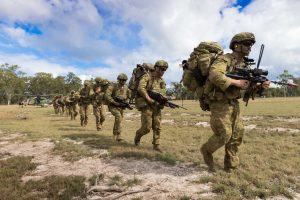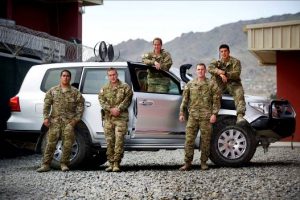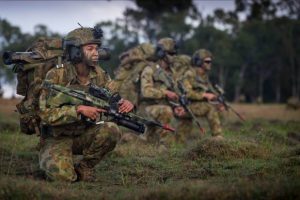This article is part 2 of a series of articles about the soldier combat system. In the first article, which you can find here, I examined the concept of the soldier as a system and discussed how to avoid the Christmas Tree effect. In this article I will go into more detail about the importance of integration.
I originally intended to write one article on integration, but as a result of some important topical issues and the breadth of the subject I have split integration into two articles. In this article I have written about integration of the soldier system with the human platform. In part 3, I will discuss other systems integration.

Soldier System Integration
In Part 1, I described the Soldier System as all the elements that together allow an individual soldier to have an effect on the battlefield. Each piece of equipment that makes up the soldier system is required to integrate with the other pieces of equipment a soldier is carrying and with the soldier’s body. This integration is achieved through interfaces that can be physical, functional, or require power and data compatibility.
In this article I will ask, how do we optimise the integration of the issued components of the soldier system with the human being who forms the core of the system? This human being is by far the most important, complex and varied system in the entire ADF. As a focus for discussing how to optimise the form and fit for different body types we will explore the issues surrounding integration of the soldier combat ensemble (SCE) with female combatants.
Scope
This is a complex and emotive subject, so let’s start by establishing some facts and boundaries.
- Females are currently close combatants in the Australian Army and over the last decade they have served outside the wire on warlike operations in Iraq and Afghanistan[1].
- Females have been training in dismounted combatant roles at establishments such as Royal Military College - Duntroon (RMC-D) for the last 30 years.
- Females are physiologically and anthropometrically different to males.
- All combatants going in to harms way, regardless of corps, size or gender, have a requirement for effective load carriage, protection and to integrate with their issued SCE.

This article identifies that the current SCE does not adequately fit some elements of the ADF demographic. An optimised equipment form and fit for female soldiers and larger male soldiers remains an area for further development. Developing a set of body armour that will better integrate with a female body would be a positive step that may also benefit some male soldiers. A desirable endstate is to establish a systematic approach to acquisition of SCE that better integrates with a wide variety of body types, both large and small.
It is beyond the scope of this article to address the entire breadth of topics related to the integration of females into combat units. Issues such as the difference in physical strength, susceptibility to injuries and cultural change have been raised and will continue to be addressed elsewhere[2]. This article will focus solely on optimising the SCE to address anthropometric differences between males and females[3].
Identifying the Problem
A longitudinal evaluation of the integration of women into combat corps found that ill fitting equipment was a widespread concern at both the School of Infantry and 1st Battalion, The Royal Australian Regiment.(1 RAR)[4]. Concerns included body armour that didn’t fit, helmets which covered soldier’s eyes, webbing not able to fit on hips and packs that did not distribute weight evenly. Earlier this year, I observed similar equipment issues with female staff cadets at an RMC-D exercise at Puckapunyal. For some female trainees, the Tier 0 Heavy Harness (H Harness belt webbing) was too long to fit their torso and the belt was too long to fit their waist[5].
Like most equipment, the SCE is required to accommodate the 5th to 95th percentile of the male and female Australian Army population[6]. The data that is used to work out the measurements that correspond to these percentages is taken from an anthropometric survey conducted by the Defence Science and Technology (DST) Group in 2012 and released in 2014. The survey collected 85 separate anthropometric dimensions from a total of 2138 ADF personnel, of whom 277 were female[7].
What does this mean for a male or female soldier who is at the edge of the spectrum for any of these measurements? It means that there is a risk that the equipment that is issued won’t be appropriate for that body type. It means that commanders and staff at training establishments need to be cognisant that the standard issued equipment is not optimised for some of their soldiers or trainees.
The size issue is further complicated when wearing both the current issue large field pack and belt webbing. The pack design was optimised to be worn with the Tiered Body Armour System (TBAS) chest platform as opposed to belt webbing. Due to the large lumber support connected to the waist band on the pack, there is physically not enough room on smaller soldiers’ backs to wear the pack and belt webbing correctly. The result is that the pack and webbing belt is worn incorrectly.
Issuing equipment that isn’t optimised for integration onto the human platform has real impact on the capability of the soldier system. Ill-fitting equipment decreases mobility, may reduce protection, increases fatigue and increases the likelihood of injury[8].
Solutions
Designing issued equipment to better fit a range of combatants has already been successful in combat clothing. The older Disruptive Pattern Camouflage Uniform (DPCU) was described as being unisex, however in reality it was a uniform designed for males that happened to fit some females. The Clothing Systems Project Office (CLOSPO) Technical Team undertook a 12 month female fit activity that aimed to provide a better fitting DPCU.
When the new Australian Multicam Camouflage Uniform (AMCU) was designed, it included the recommendations from the female fit trial, so that AMCU provides a true unisex uniform. Some of the changes between DPCU and AMCU include an increased size range, changes to sleeve length, button locations and the shape of the shirt body. The end result is that the current uniform integrates better with the wide variety of body types of the people wearing it[9]. There is an opportunity for other components of the SCE to be similarly designed to account for the wide range of sizes of soldiers who will use that equipment.

Multiple Size Ballistic Plates
Part 1 of this series talked about the importance of balancing physical protection and mobility to achieve survivability. One of the most important components in this protection subsystem is the hard ballistic plate. The plate works together with soft armour inserts inside the TBAS carrier to provide protection from threats including high velocity and armour piercing rifle rounds. To balance protection and mobility, the ballistic plates must be large enough to protect important internal organs, while not being overly large, contributing to a loss of mobility.
Unlike earlier generations of ballistic protection, TBAS does not come with different size ballistic plates, as one size has been deemed suitable for all combatants. There are logistic and cost advantages to only using one plate size. The decision to only issue one plate size was informed by Defence scientists based on knowledge of internal organ location in the body. DST Group has continued to improve their knowledge about organ location by mapping the locations of the internal organs of 23 male and 3 female soldiers using Magnetic Resonance Imaging (MRI).
DST Group has acknowledged that previous efforts to improve armour design have been focused on male user groups. However, the question of multiple plate sizes is just as relevant to large soldiers receiving the optimal physical protection as it is to small soldiers having optimal mobility. The next generation of the SCE will be delivered by Project Land 125 Phase 4. This Project provides an opportunity for DST Group to conduct further research into the benefits and costs of multiple plate sizes and optimising armour for combatants of all sizes and both genders.
Shaped Body Armour
The upper torso of male and some female combatants is one of the areas where anthropometric differences are most apparent. These differences may result in less protection provided by the ballistic plates. Females are not just small males, and the different shape of female anatomy requires different considerations for protection[10].
The current ballistic plate, the CIB 28, has a slight curve in the plate that is better suited for a male chest. Anecdotal evidence from some females indicates there are comfort and breathing issues associated with wearing this plate. However, not all females have reported this problem and some find the current plate suitable.
Because the different protection components work together as a system, making a curved ballistic plate would require a redesign of the entire TBAS. There are a number of other challenges in designing and issuing shaped body armour. For example, conducting the required ballistic testing is more complex for a curved plate[11]. Sizing for the curvature is also complex and it would be costly for the ADF logistic system to cater for every conceivable size. A selection of curved plate options could offer some female combatants a system with greater comfort and protection, increasing their overall fighting capability.
The law enforcement community and allied militaries have conducted some research into this area, though there are limitations to how far this research has gone. Law enforcement armour tends to focus on low velocity and stab/ spike threats rather than high velocity rounds. In 2012, the US Army trialled female body armour that featured a redesigned carrier, an outer pocket for the front ballistic plate and smaller side plates. It still used the same front and back ballistic plates, but female soldiers reported greater comfort.
Two organisations in the US, Program Executive Office (PEO) Soldier and Gruntworks, are continuing efforts into female specific body armour. The latest version of body armour developed for US troops is the Female Improved Outer Tactical Vest (FIOTV)[12]. The weight of numbers and resources that the US military has means that the Australian Army should remain closely connected to our allies’ efforts in this area.

Outliers
There will always be some soldiers, who because of their unique body type, don’t fit into issued gear. For these individuals there should be a choice between using the existing gear, having issued equipment modified or purchasing a better fitting alternative from a commercial retailer. There needs to be some control over this approach, requiring permission and purchasing off an approved list: this approach has worked for boots for some time. Importantly this needs to be properly funded by Army and properly communicated to soldiers so the right people can access the right gear.
This approach will not work for everything. It is not possible to give people the choice about the ballistic plates they wear because of the extremely rigorous testing that goes into ballistic protection. For these systems there is always going to be a limited number of issued components that can be managed by the ADF logistic chain. The challenge is to optimise the size and shape of ballistic plates for the greatest number of soldiers.
Bespoke Solution
The ideal solution to all the issues raised in this article would be a completely bespoke set of SCE developed for each soldier. Like getting a tailored suit on your wedding day, this would fit the SCE to each individual and optimise the integration between equipment and human platform. The end result would be a soldier system with greater mobility, protection, reduced chance of injury and overall, greater capability.
This solution is probably still some years off, but Army may consider looking into this area now to determine when, if ever, it would be feasible to implement a fully customised, bespoke SCE. The proliferation of new techniques such as 3D printing and continual reduction of new technology costs could make this possible, but key questions remain: what is the likelihood of success, what technologies are required and when will these technologies mature?

Where do we go from here?
The integration between the SCE and the human being who wears it is an extremely important consideration for system design. It is important that all combatants are considered when designing elements of the soldier system, as the level of this integration has a direct correlation to performance in combat.
There are several ways that the ADF can improve the integration between issued equipment and soldiers.
- Firstly, new equipment needs to be designed with female combatants in mind, rather than designed for men and then simply made smaller for females. Females are not just small men! This has been done successfully with the introduction of the new AMCU uniform.
- Secondly, further research should be conducted by DST Group to inform the decision regarding multiple sized plates to ensure that the protection/ performance trade off is balanced for combatants of all sizes.
- Thirdly, the ADF can begin initial research into two areas related to shaped body armour. The first is how ballistic assurance testing will be carried out for curved plates. The second is answering the question of whether curved plates do in fact offer increased comfort, protection and fighting capability to female soldiers. The ADF should seek and share information with our allies as much as possible during this process.
- The fourth step the ADF can do is to provide options and funding for personnel at extreme ends of the size spectrum to modify equipment or purchase off the shelf products for some components of their SCE.
- The final step is to consider a study into the possibility of completely bespoke SCE to achieve true integration between soldier and equipment. This will go some way to realising the optimisation of the soldier system.
If you are a soldier with a shorter stature or you tower above the average person, then you need to make your voice heard. Tell us at Diggerworks your experience using issued equipment and body armour. If you have the option of participating in a DST group study or trial, take advantage of the opportunity to influence the design of future versions of SCE and TBAS.
In this article I haven’t addressed cost or the acquisition strategy. There are smart ways that the ADF can conduct this acquisition and make it affordable. This can be achieved by using strategies such as adaptive acquisition and will be the subject of the final part of this series.










Great article!
It leads me to ask an essential question:
With all this theoretical knowledge that fitting equipment to the human frame is absolutely essential, why then is the practical application of that knowledge so sadly lacking?